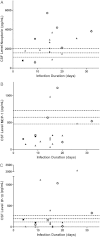Central nervous system viral invasion and inflammation during acute HIV infection
- PMID: 22551810
- PMCID: PMC3490695
- DOI: 10.1093/infdis/jis326
Central nervous system viral invasion and inflammation during acute HIV infection
Abstract
Background: Understanding the earliest central nervous system (CNS) events during human immunodeficiency virus (HIV) infection is crucial to knowledge of neuropathogenesis, but these have not previously been described in humans.
Methods: Twenty individuals who had acute HIV infection (Fiebig stages I-IV), with average 15 days after exposure, underwent clinical neurological, cerebrospinal fluid (CSF), magnetic resonance imaging, and magnetic resonance spectroscopy (MRS) characterization.
Results: HIV RNA was detected in the CSF from 15 of 18 subjects as early as 8 days after estimated HIV transmission. Undetectable CSF levels of HIV (in 3 of 18) was noted during Fiebig stages I, II, and III, with plasma HIV RNA levels of 285651, 2321, and 81978 copies/mL, respectively. On average, the CSF HIV RNA level was 2.42 log(10) copies/mL lower than that in plasma. There were no cases in which the CSF HIV RNA level exceeded that in plasma. Headache was common during the acute retroviral syndrome (in 11 of 20 subjects), but no other neurological signs or symptoms were seen. Intrathecal immune activation was identified in some subjects with elevated CSF neopterin, monocyte chemotactic protein/CCL2, and interferon γ-induced protein 10/CXCL-10 levels. Brain inflammation was suggested by MRS.
Conclusions: CSF HIV RNA was detectable in humans as early as 8 days after exposure. CNS inflammation was apparent by CSF analysis and MRS in some individuals during acute HIV infection.
Figures




References
-
- McArthur JC, Hoover DR, Bacellar H, et al. Dementia in AIDS patients: incidence and risk factors. Multicenter AIDS Cohort Study. Neurology. 1993;43:2245–52. - PubMed
-
- Heaton RK, Marcotte TD, Mindt MR, et al. The impact of HIV-associated neuropsychological impairment on everyday functioning. J Int Neuropsychol Soc. 2004;10:317–31. - PubMed
-
- Tozzi V, Balestra P, Lorenzini P, et al. Prevalence and risk factors for human immunodeficiency virus-associated neurocognitive impairment, 1996 to 2002: results from an urban observational cohort. J Neurovirol. 2005;11:265–73. - PubMed
-
- Ellis RJ, Moore DJ, Childers ME, et al. Progression to neuropsychological impairment in human immunodeficiency virus infection predicted by elevated cerebrospinal fluid levels of human immunodeficiency virus RNA. Arch Neurol. 2002;59:923–8. - PubMed
Publication types
MeSH terms
Substances
Grants and funding
LinkOut - more resources
Full Text Sources
Medical

